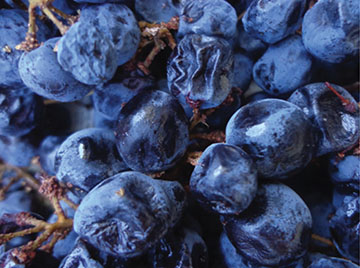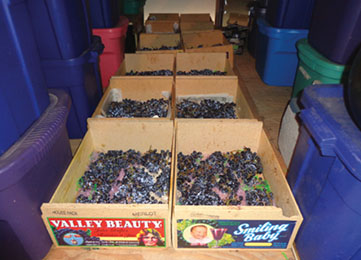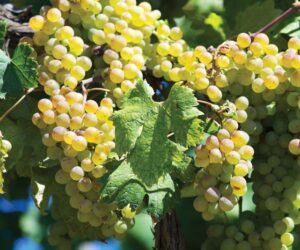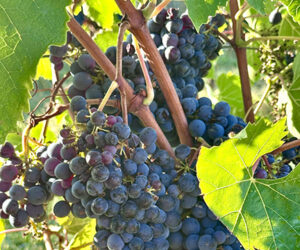 Italy is one of the world’s largest wine producers by volume, accounting for about one-third of global output. Not only are grapes grown in almost all regions of the country, there are a great many vineyards under cultivation. When most people think of Italian wine, the grape varieties that are likely to come to mind are Tuscany’s Sangiovese (the primary grape in Chianti), Piedmont’s Nebbiolo (the grape that makes both Barolo and Barbaresco), Sicily’s Nero d’Avola, and Pinot Grigio from Lombardy and Trentino-South Tyrol. Besides these four grapes, Italy’s Ministry of Agriculture and Forestry has given “authorized” status to more than 350 other varieties. Many of these indigenous grapes are largely unknown outside their region of origin. In this article I will introduce you to a region of Italy that is home to three grape varieties and to a winemaking method that have never been featured in WineMaker magazine, all of which yield one of the world’s most prized “straw” wines, namely Amarone, which comes from the Valpolicella zone of the Veneto region.
Italy is one of the world’s largest wine producers by volume, accounting for about one-third of global output. Not only are grapes grown in almost all regions of the country, there are a great many vineyards under cultivation. When most people think of Italian wine, the grape varieties that are likely to come to mind are Tuscany’s Sangiovese (the primary grape in Chianti), Piedmont’s Nebbiolo (the grape that makes both Barolo and Barbaresco), Sicily’s Nero d’Avola, and Pinot Grigio from Lombardy and Trentino-South Tyrol. Besides these four grapes, Italy’s Ministry of Agriculture and Forestry has given “authorized” status to more than 350 other varieties. Many of these indigenous grapes are largely unknown outside their region of origin. In this article I will introduce you to a region of Italy that is home to three grape varieties and to a winemaking method that have never been featured in WineMaker magazine, all of which yield one of the world’s most prized “straw” wines, namely Amarone, which comes from the Valpolicella zone of the Veneto region.
What is a straw wine? Simply put, it is a wine made from grapes that have been partially dried on straw mats to concentrate their juice prior to fermentation. After describing some of the details about this wine and the region from which it comes, in this article I will outline how you can mimic this winemaking style in your home winery by using a combination of Italian grape juice and partially dried red grapes.
The Veneto Region and the Valpolicella Area
Veneto, located in the northeast area of Italy, is the country’s fifth most populated of the 20 regions, with five million residents and a rich cultural history. The region’s capital and largest city is Venice, the wondrous “City of Canals.” Veneto was once part of the Republic of Venice, which was an independent state for more than a thousand years. Then, in the early 1800s, Napoleon’s army conquered Venice and the Veneto became part of the Austrian Empire before becoming part of the Kingdom of Italy in 1866.
About 100 miles (~160 km) west of Venice is Verona, a jewel of a city with 265,000 inhabitants that is home to Shakespeare’s mythical characters, Romeo and Juliet, and is also the setting for two other well-known plays by The Bard, namely, The Two Gentlemen of Verona, and The Taming of the Shrew. Built by the Romans in the 2nd century B.C. as a military camp, by the beginning of the 1st century A.D. Verona was a wealthy town. Today, a number of the buildings and structures erected 2,000 years ago are still standing and functional, especially Verona’s Roman amphitheater, which is half the size of the Coliseum in Rome. Located in the heart of the city, this amphitheater is so well preserved that it is the venue for summer opera festivals that run from mid June until the end of August.
Just outside Verona, as you drive north and west towards the largest lake in all of Italy, Lake Garda, are the rolling hills of the Valpolicella region, which is the second largest producer of wines in Italy. The name “Valpolicella” derives from a Latin and Greek phrase for “Valley of Cellars,” which refers to the fact that 2,000 years ago the Roman Empire relied upon this region for a good deal of its wine production. Credit for the grape varieties that the Valpolicella became known for over the past 800 years goes to the Catholic monks who replanted the vineyards during the Middle Ages. Fast forward to the last few decades of the 20th century when many new vineyards were planted in the high altitude hillside locations where poor soils forced the vine roots to dig deep for water and nutrients. The result was lower producing vines with higher quality grapes that have brought newfound fame to this region of Veneto.
Valpolicella Red Grapes and Their Notable Wines
When talking about red wines, Valpolicella is known primarily for two grape varieties: Corvina and Rondinella. Corvina is the more important of the two, which is why it is referred to as the “Queen” grape. This blue-black colored grape reaches its full potential only in the Valpolicella region, providing its famous sour-cherry character, as well as body and structure to a wine. Its scent is initially floral, but over time, becomes fruitier. In 2005, DNA analysis found that Corvina was a parent variety to Rondinella, which is a rustic, black-violet colored grape that has a gentle aroma, low tannins, and fresh herbal flavors.
One additional noteworthy red grape in the Valpolicella region is Molinara, a reddish-violet colored variety that is primarily valued as a blending grape due to its naturally high acidity that helps flesh out wines that are blended with Corvina and Rondinella. Together, these three grape varieties produce Amarone, but they also are used for other notable wines in the region, producing startling different taste sensations based on when the grapes are picked, what quality of grapes are used, and what is done afterwards.
The most basic red wine in the region that uses this three- grape blend is Valpolicella Classico, a dry, light-bodied, everyday-drinking wine that is fermented in tanks, bottled within six months, and typically served chilled. This wine, when made well, has a delicate acidic texture, with cherry flavors and floral aromas. It is often compared favorably to the French Beaujolais Nouveau wines.
In contrast to the youthful freshness of Valpolicella Classico, Recioto della Valpolicella is an intensely flavored, sweet red wine made in the straw-wine style by partially drying these same three grape varieties and then stopping fermentation before the yeast fully consume the grapes’ sugars. The straw winemaking method was first developed thousands of years ago by the ancient Greeks and was later adopted by the Romans who ruled the Valpolicella region. Confronted with the cool climate of western Veneto, Valpolicella winemakers have relied upon this method for centuries as a way to increase their wines’ body and complexity. Recioto’s sweetness and richness make it a perfect after-dinner drink.
A third wine style in the region that is a direct byproduct of both Valpolicella Classico and Recioto della Valpolicella is the “beefed up” Valpolicella Superiore Ripasso. This more robust red wine has as its base the standard Valpolicella wine. However, after primary fermentation is complete the young wine goes through a brief refermentation and intensifying process that imparts more flavor and color to the wine when it is passed over the partially dried and freshly fermented grape skins of the Corvina, Rondinella, and Molinara blend; ripasso means “repassed.” After a second pressing, the wine is aged in oak barrels for at least a year.
The Amarone Winemaking Process
The Valpolicella straw winemaking tradition reached further heights in the 1950s with the creation of Amarone della Valpolicella, yet truth be told, this wine’s birth was supposedly an accident. As the story goes, the first Amarone was created when a winemaker allowed a barrel of Recioto wine to ferment too long, eliminating its residual sugar, resulting in a dry and powerfully full-bodied wine. At first, this new wine style was known as Recioto Amaro; in Italian, amaro means “bitter,” and the wine was so named because of its tart, raisiny flavor. Over time, the amaro term became the now-familiar Amarone. In 2009, Amarone della Valpolicella earned Denominazione di Origine Controllata e Garantita (DOCG) status, which is Italy’s official top-tier wine classification.
Amarone is a relatively high priced wine, typically starting at about $50 per bottle. These prices are due to the labor intensity of the winemaking process and the large number of high-quality grapes needed for each bottle. In most of the world’s winemaking regions it takes about 2.5 pounds (1.13 kg) of grapes to produce one bottle of wine. However, due to the required drying process for Amarone, one bottle of wine requires at least twice as many grapes, and most wineries select their older, more mature vines for this wine. Amarone della Valpolicella must undergo at least two years of aging prior to its release for sale. Once bottled, this wine has long-aging potential, with properly stored bottles lasting splendidly for more than 30 years.
In producing Amarone, regulations stipulate that Corvina must constitute between 45% and 95% of the final blend, Rondinella must comprise between 5% and 30%, and Molinara can fill in the remaining percent, but cannot exceed 25%. In fact, Molinara is the only grape in this blend that can be replaced with some other indigenous red grape. These grapes are typically harvested ripe in the first two weeks of October by carefully choosing bunches having high-quality berries that are not too close to each other, to let the air flow. The grapes are then allowed to dry, traditionally on graticci or straw mats, in the winery attic. This process is called appassimento or rasinate (to dry and shrivel) and it concentrates the grapes’ sugars, and integrates the tannins. During the 60-120 days of appassimento, the grapes will lose 30%-40% of their weight. They are not actually raisins at this point because they still contain enough moisture to make wine. These now highly sugared shriveled grapes usually require specific strains of hearty yeasts to fully ferment the wine, ultimately yielding alcohol levels ranging from 14% to the more traditional 16%.
Since the 1990s, the trend has been toward a shorter grape drying period with fruitier and somewhat lower alcohol levels, and the straw mats have mostly been replaced with plastic racking that is stackable but allows air flow between and over each grape. Modern Amarone is now mostly produced in special drying chambers under controlled conditions, which minimizes the amount of handling that the grapes go through and reduces the likelihood of Botrytis cinerea, a fungus often referred to as “Noble Rot,” which in the case of Amarone would be a spoilage mold. After fermentation, the wine is aged in barrels made from either French or Slavonian oak. The final result is a very ripe, raisiny, full-bodied wine with very little acid.

Making Amarone-Style Wine
Now that I have described the grapes that make up Amarone and how this wine is made in Italy, allow me to describe how you can make an Amarone-style wine using two different sources for grapes and grape juice. Of course, what I am about to describe is not the only way in which you can mimic the Amarone-style of winemaking, so please take what I state here as simply one way you can approach this winemaking style.
Over the past few years, juice distributors in North America have offered 6-gallon (23-L) buckets containing a blend of Italian grape juice from Corvina, Molinara, and Rondinella grapes grown in the Valpolicella region. Often these juices are advertised as “Amarone,” but now that you understand how Amarone is made, you realize that these three grape combinations do not simply and automatically yield Amarone wine; it is a much more complicated process. Given that fact, it might be more correct to label this particular grape juice combination as “Valpolicella Classico.” However, if you purchase this juice with the three necessary grapes contained within, you could mimic the Amarone process by adding to it partially dried red grapes that are close in style to these Italian grapes. Now, of course, you will be hard pressed to find any commercial grape distributor or vineyard owner who sells partially dried red grapes, but they do sell freshly picked grapes, which you can then turn into partially dried grapes by using the appassimento process.
In September 2013, I purchased three 6-gallon (23-L) buckets of Italian “Amarone” juice and I also purchased from a local Milwaukee fruit distributor two 36-pound (16-kg) lugs of California Cabernet Sauvignon grapes. I did try to locate American-grown Corvina grapes because they are grown in limited quantities in California, but when this proved fruitless — pun intended — I settled on the robust Cabernet Sauvignon grape as a suitable replacement. The California grapes arrived in Milwaukee ten days before the Italian juice, so I immediately placed these fresh grapes into wooden crates containing a combination of “paper straw” and plastic Easter basket straw, and then placed these containers in my warm garage attic to begin the appassimento process (see photo above).
In drying your grapes, a low humidity setting is crucially important; moist air is a breeding ground for fungal infection. To further reduce the risk of infection, prior to placing your grapes on their straw beds, remove any with damaged skins. Also, use fans or dehumifiers in the drying area to increase dry air circulation.
When the Italian juice arrived, I placed the buckets into my garage refrigerator while I continued drying the California grapes. After 17 days of the appassimento process in my garage attic, the 72 pounds (33 kg) of Cabernet Sauvignon grapes now weighed 50 pounds (23 kg), or 69 percent of their original weight (see photos, above) and I could no longer measure their sugar levels using my refractometer; the Brix was well above 32°! Although my grape-drying time was considerably shorter than the standard duration, this 31 percent reduction in volume mimicked the weight loss in the Amarone-making process, while minimizing the risk of fungal infection. These partially dried grapes were now ready for crushing, so after removing the three buckets of Italian juice from cold storage and pouring their contents into a large food-grade plastic primary fermenter, I de-stemmed and crushed the partially dried grapes by hand and added them to the juice.
Prior to starting fermentation, the pH level of the must was 3.39 and the specific gravity was 1.110 (25.8 °Brix), meaning that if fermented to dryness, this Amarone-style wine would be slightly above 14% alcohol. This alcohol content is at the lower end of a typical Amarone wine, but is perfectly understandable given that only a small portion of the juice came from partially dried grapes. I wrapped heating blankets around my fermenter to warm up the juice. When the temperature reached 60 °F (15.5 °C) I added a natural yeast rehydration nutrient, Go-FermProtect, to a few ounces of water and then rehydrated freeze-dried Lalvin K1-V1116 yeast and inoculated the must. I selected this yeast strain primarily because it can handle high-alcohol levels and reduces the likelihood of a stuck fermentation. To improve body and color stability, and also help reduce any burning sensations common in higher alcohol wines, I added in some Noblesse, an inactivated yeast product. For good measure I also added in a very small portion of medium-toast French oak chips (two ounces).
By the following morning a nice cap had formed on the now-fermenting must and I conducted three gentle punch downs each day, measuring the temperature and specific gravity of the must at each punch down. On the second day of full fermentation, when the yeast had consumed one-third of the sugar in the must, I added some Fermaid-K to provide additional nutrients to the yeast. At this time I also inoculated the must with Wyeast Malolactic cultures, which began the process of converting the harsher malic acids in the newly forming wine into softer lactic acids.
At the beginning of the sixth day of fermentation, with the must’s cap more mushy to the touch than firm and with the specific gravity now at 1.000 (0 °Brix), I pressed the juice off the grape skins, yielding just over 21 gallons (79 L) of new wine. A week after pressing, I racked the new wine off the gross lees and allowed it to continue its malolactic fermentation, stirring up the fine lees from the bottom of each carboy about every five days to infuse the fine lees’ rich flavors into the maturing young wine. Within a month, malolactic fermentation was complete and I then sulfited the wine and began cold stabilizing it for 18 days in my garage refrigerator. I always cold stabilize my red wines prior to racking them into oak barrels to minimize the build up of tartrate crystals on the barrels’ inside walls. After racking the now-stabilized wine off its tartrate crystals and into a 20-gallon (76-L) oak barrel for long-term aging, its total acidity was six grams per liter, or 0.6 percent. During the subsequent 13 months of barrel aging I did not rack the wine but did make two sulfite additions. At the end of barrel aging, I racked the wine into glass carboys and bottled two weeks later. No fining or filtering occurred prior to bottling.
Sixteen months after bottling, this Amarone-style wine has a dark purple-red color and a rich, plummy aroma, with a leathery, earthy, blackberry taste and a slight perception of dark chocolate sweetness, despite the fact that it is totally dry. The tannins are firm and the aftertaste is decidedly alcoholic, which is true to the Amarone style. Is this a true Amarone wine? No. Amarone comes only from the Valpolicella region of Italy. But the wine I made has a taste typical of the Amarone style. Maybe it is time for you to try making an Amarone-style wine yourself. Experimentation can be very satisfying. Ciao!







